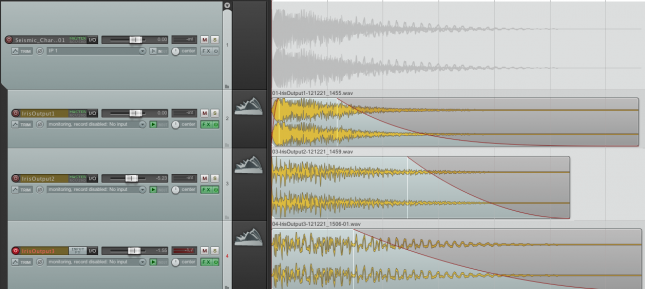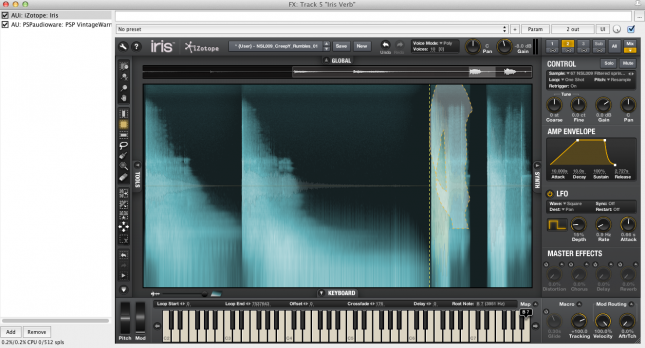Tor Johnson over at New Sound Lab has recently released “NSL009 Spring Reverb.” From Tor’s description:
“This library features recordings created using a “Knas Ekdahl Moisturizer“, a boutique spring reverb effects unit where three reverb springs are exposed, allowing them to be hit, played, and manipulated in real time. The unit also includes a multi-mode analog filter, and when combined with the playability of the springs, opens up many sound creation options.”
This collection of 872 sounds is a fantastic mix of scrapes, drags, plucks, hits and rattles:
[soundcloud url=”http://soundcloud.com/newsoundlab/nsl009-spring-reverb”]
I am absolutely in love with how cool these sounds are. While browsing through the list of sounds the second one set off my imagination. The first hit of “02 NSL009 Spring hits with allen wrench prepared 01.wav” immediately made me think of the Seismic Bomb from Attack of the Clones. Taking two different Spring hits I filled in some higher frequencies as well as a bottom end boost to fill in the sound.

Using just NSL009 samples in Iris with a bit of compression EQ I was able to get a (very) vague approximation in less than 20 minutes!
(Soundcloud embedding is still giving us sass, please use this link to listen): “https://soundcloud.com/designingsound-org/springreverb-review”
This library also seems very well suited to making creepy sorts of ambiences and rumbles. Again, just by plugging 2 samples into Iris (one for the meat of the sound and other to add some high-end and variance) and with minimal tweaking of Iris itself as well as some compression I was able to get a pretty cool sounding rumbly/growl effect happening that I need to find a use for:
“https://soundcloud.com/designingsound-org/springreverb-review-1”
The $35.00 price tag certainly warrants picking it up to just play around with and explore the possible uses of what Tor Johnson has put together. While it’s immediate use in your arsenal might not be apparent I am fairly confident that I personally will find a great many uses for this set of sounds.
Tor Johnson was nice enough to answer a few questions about his new library:
Designing Sound: Why did you decide to record a reverb effects unit in such a unique way? Why did you pick the Knas Ekdahl Moisturizer unit specifically?
Tor Johnson: I decided to create a library of metallic impacts, scrapes and rattles, but I wanted the sounds to have a different tone and texture than what you would normally expect. I’ve always liked the idea of using mechanical reverbs as percussion instruments, and the physical flexibility of a spring reverb would allow me to create some interesting sounds. The Knas Ekdhal Moisturizer is a high-quality and very unique unit that is designed perfectly for this library. Also, the built-in filter section adds a lot more possibilities for new sounds.
DS: The Knas Ekdahl Moisturizer is actually a fairly small device compared to something like an EMT 140 Plate Reverb we featured last week. I am surprised you were able to get such big sounds out of such a small package, any specific techniques enable you to do that?
TJ: Initially, I was also surprised to get big sounds out of this unit. My previous experience with using spring reverbs in a traditional way like in a guitar amp, or a Roland Space Echo is that the sound is lo-fi and thin in contrast to the richness of a large plate reverb. But, because I was physically hitting and scraping the spring coils themselves, the sounds actually have a lot of depth. I experimented with different tools to create the largest sounding impacts and bring out the resonance of the springs. The spring reverb I used is a three spring coil unit, which has a fuller, deeper and more complex sound compared with a two spring unit. Also, I used an excellent analog preamp, a Neve 1073, which adds a lot of roundness and punch to the recordings.
DS: Was there any combination of objects that you used on the springs that created a surprising sound, even to you?
TJ: When I wedged a Q-tip between the springs before hitting them with a metal rod, I was surprised how the oscillation of the springs was amplified. The Q-tip extended the reverb decay time and caused an interesting drawn-out drone effect. Also, I was able to create different pitches and tones by stretching the springs horizontally while hitting them. Surprisingly, the springs survived all the abuse.
DS: Is there anything you learned in the course of putting together this library that will be useful in your next project?
TJ: The process to create this library was different than most of the field recording projects I’ve worked on. Working in a controlled studio environment without using microphones allowed me to focus more on creating the sounds themselves, and less on the technical aspect of the recording. One challenge though, was that the output transducer on the spring coils was sensitive, and it didn’t take a lot playing force to distort the output, so I had to use restraint to find the sweet spot for getting a quality sound. Because of this, I experimented with a lot of different impact velocities and playing styles, and at times it was like a scripted performance to capture the sound I was looking for. I’m looking forward to applying this approach of well thought out and focused performance to add nuance and character into my recordings.
DS: Thank you for speaking with me Tor!
TJ: Thank you for the opportunity to chat about the library!
A review copy of the library was provided by Tor Joshnson of New Sound Lab.


[…] Read the full article here: New Sound Lab’s Spring Reverb. Interesting approach […]